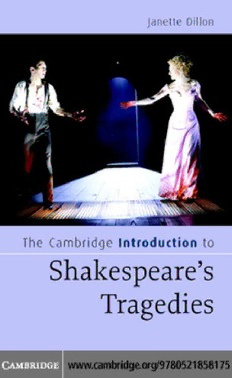
The Cambridge introduction to Shakespeare's tragedies PDF
Preview The Cambridge introduction to Shakespeare's tragedies
This page intentionally left blank TheCambridgeIntroductionto Shakespeare’s Tragedies Macbethclutchesanimaginarydagger;HamletholdsupYorick’sskull; LearenterswithCordeliainhisarms.Dothesememorableandiconic momentshaveanythingtotellusaboutthedefinitionofShakespearean tragedy?Isitinfacthelpfultotalkabout‘Shakespeareantragedy’asa concept,orarethereonlyShakespeareantragedies?Whatkindoffigure isthetragichero?Istherealwayssuchafigure?Whatmakessomeplays moretragicthanothers?Beginningwithadiscussionoftragedybefore ShakespeareandconsideringShakespeare’stragedieschronologically onebyone,thisbookseekstoinvestigatesuchquestionsinawaythat highlightsboththedistinctivenessandthesharedconcernsofeachplay withinthebroadtrajectoryofShakespeare’sdevelopingexplorationof tragicform. JanetteDillonisProfessorofDramaattheSchoolofEnglish,University ofNottingham. Cambridge Introductions to Literature Thisseriesisdesignedtointroducestudentstokeytopicsandauthors. Accessibleandlively,theseintroductionswillalsoappealtoreaderswho wanttobroadentheirunderstandingofthebooksandauthorstheyenjoy. (cid:1) Idealforstudents,teachers,andlecturers (cid:1) Concise,yetpackedwithessentialinformation (cid:1) Keysuggestionsforfurtherreading Titlesinthisseries: EricBulson TheCambridgeIntroductiontoJamesJoyce JohnXirosCooper TheCambridgeIntroductiontoT.S.Eliot KirkCurnutt TheCambridgeIntroductiontoF.ScottFitzgerald JanetteDillon TheCambridgeIntroductiontoEarlyEnglishTheatre JanetteDillon TheCambridgeCompaniontoShakespeare’sTragedies JaneGoldman TheCambridgeIntroductiontoVirginiaWoolf KevinJ.Hayes TheCambridgeIntroductiontoHermanMelville DavidHoldeman TheCambridgeIntroductiontoW.B.Yeats M.JimmieKillingsworth TheCambridgeIntroductiontoWaltWhitman RonanMcDonald TheCambridgeIntroductiontoSamuelBeckett WendyMartin TheCambridgeIntroductiontoEmilyDickinson PeterMessent TheCambridgeIntroductiontoMarkTwain JohnPeters TheCambridgeIntroductiontoJosephConrad SarahRobbins TheCambridgeIntroductiontoHarrietBeecherStowe MartinScofield TheCambridgeIntroductiontotheAmericanShortStory EmmaSmith TheCambridgeIntroductiontoShakespeare PeterThomson TheCambridgeIntroductiontoEnglishTheatre,1660–1900 JanetTodd TheCambridgeIntroductiontoJaneAusten JenniferWallaceTheCambridgeIntroductiontoTragedy The Cambridge Introduction to Shakespeare’s Tragedies JANETTE DILLON CAMBRIDGEUNIVERSITYPRESS Cambridge, New York, Melbourne, Madrid, Cape Town, Singapore, São Paulo Cambridge University Press TheEdinburghBuilding,CambridgeCB28RU,UK Published in the United States of America by Cambridge University Press, New York www.cambridge.org Information on this title: www.cambridg e.org /9780521858175 ©JanetteDillon2007 Thispublicationisincopyright.Subjecttostatutoryexceptionandtotheprovisionof relevantcollectivelicensingagreements,noreproductionofanypartmaytakeplace withoutthewrittenpermissionofCambridgeUniversityPress. Firstpublishedinprintformat 2007 ISBN-13 978-0-511-27151-9 eBook (Adobe Reader) ISBN-10 0-511-27151-4 eBook (Adobe Reader) ISBN-13 978-0-521-85817-5 hardback ISBN-10 0-521-85817-8 hardback ISBN-13 978-0-521-67492-8 paperback ISBN-10 0-521-67492-1 paperback CambridgeUniversityPresshasnoresponsibilityforthepersistenceoraccuracyofurls forexternalorthird-partyinternetwebsitesreferredtointhispublication,anddoesnot guaranteethatanycontentonsuchwebsitesis,orwillremain,accurateorappropriate. Contents Acknowledgements page vi Introduction 1 Chapter1 TragedybeforeShakespeare 7 Chapter2 TitusAndronicus 25 Chapter3 RomeoandJuliet 40 Chapter4 JuliusCaesar 52 Chapter5 Hamlet 65 Chapter6 Othello 77 Chapter7 TimonofAthens 91 Chapter8 KingLear 103 Chapter9 Macbeth 114 Chapter10 AntonyandCleopatra 126 Chapter11 Coriolanus 140 Notes 153 Index 166 v Acknowledgements Quotations from Shakespeare’s tragedies, except where otherwise indicated, arefromtheArdenthirdserieswhereavailable,andtheArdensecondseries otherwise.QuotationsfromShakespeare’sotherplaysarefromTheRiverside Shakespeare,gen.ed.G.BlakemoreEvans,2ndedn(Boston:HoughtonMifflin, 1997). Since Shakespeare is almost always quoted in modern spelling, I have modernisedthespellingofallcontemporaryquotationsforconsistencywith this practice. The drawing attributed to Henry Peacham, possibly of Shake- speare’sTitusAndronicus,page27,isreproducedbypermissionoftheMarquess ofBath. IamindebtedtoBreanHammondforreadingthewholetypescriptindraft, andtotheusualsuspectsforsharingconversationsonShakespeareantragedy. Theyknowwhotheyare.IamgratefultooforthesupportofSarahStantonat CambridgeUniversityPress. vi Introduction Imaginethat,asinthecurrentvogueofSaturdaynightBritishtelevision,you arewatchingtheTop100ShakespeareanTragicMoments.Whatwillreachthe topfive?Macbethclutchingatanimaginarydagger?LearwithCordeliainhis arms?Cleopatraholdingtheasptoherbreast?JulietfallingonRomeo’sbody? NumberonewouldsurelyhavetobeoneoftwoiconicmomentsfromHamlet: ‘Alas, poor Yorick’ or ‘To be or not to be’. Do these moments have anything incommonthathelpsustowardsadefinitionofShakespeareantragedy?The onlymoreorlesscommonfactorisperhapsarelentlessfocusonthesolitary individual;butthismaybelessaneffectofShakespeareantragedyitselfthanof apost-RomanticwayofreadingShakespeareantragedyalmostsolelythrough thelensofthetragichero.OfcourseShakespeareantragediesdohaveheroes, somemoreheroicthanothers,andoneortwoveryhardindeedeithertoadmire ortosympathisewith(CoriolanusorTimon,forexample).Thesemoments, however,arelessindividuallyfocusedthantheymayappeartobeatfirstglance. LearandJulietarebothembracingalostlovedoneandLearissurroundedby otherpeopleinthatmoment;Cleopatrahastostruggletogetridoftheclown before she can put the asp to her breast, and Charmian remains at her side forthemomentitself;HamletiswithHoratioandhasbeenexchangingjokes withthegravediggerwhenthegravediggerthrowsupYorick’sskull;Hamletis observedbyClaudius,PoloniusandOpheliawhenheponderswhethertolive ordie.OnlyMacbethisalonewhenhereachesforthedagger. NeitherShakespeareantragedynorearlierElizabethantragedywouldusu- ally emphasise the individual to the exclusion of the state. Indeed a feature sharedbyallShakespeare’stragedies,aswellasbymostofthetragedieswritten by Shakespeare’s contemporaries, is that their closure depends on a restora- tionofpoliticalorderfollowingthecentraldeathordeathsofindividuals.If weweretofocusontheclosingscenesofShakespeare’stragediesratherthan those moments that have permeated the collective memory, we would find thatthestageisusuallyfullandthefocusisontwothings:howthetragichero will be remembered and how the rest will carry on. And if, alternatively, we pickoutmomentsthatappearinsignificantandareoftencutinperformance, 1 2 TheCambridgeIntroductiontoShakespeareanTragedies we will go further towards understanding not only what is distinctive about Shakespeareantragedybutwhatisdistinctiveabouteachtragedy.Inchapters thatfollow,therefore,oneapproachtobepursuedisthecloseanalysisofpar- ticular moments, some apparently peripheral, in order to examine how they speak of the play’s particular concerns. Characters who appear in one scene only, like Lady Macduff in Macbeth or Cornwall’s servant in Lear, may be as importanttotheshapingoftragedyasthedesignatedtragichero. Itisprobablyneitherpossiblenordesirabletofindaone-size-fits-alldefini- tionoftragedy,thoughtheattemptisoftenmade. Tragedy,then,isanimitationofanactionthatisserious,complete,andofa certainmagnitude;inlanguageembellishedwitheachkindofartisticornament, theseveralkindsbeingfoundinseparatepartsoftheplay;intheformofaction, notofnarrative;throughpityandfeareffectingtheproperpurgationofthese emotions. ... ThePlot,then,isthefirstprinciple,and,asitwere,thesoulofatragedy: Characterholdsthesecondplace. Aristotle,Poetics,ch.VI Atragedyisastoryofexceptionalcalamityleadingtothedeathofamaninhigh estate. A.C.Bradley,ShakespeareanTragedy(1904) Inaesthetics,tragedyisthequalityofexperiencewhereby,inandthroughsome seriouscollisionfollowedbyfatalcatastropheorinnerruin,somethingvaluablein personalitybecomesmanifest,eitherassublimeoradmirableinthehero,oras thetriumphofanidea.Thesituationitselforitsportrayalistermedtragedy.The characteristicsubjectiveeffectisthatofacomplexofstronglypainfuland pleasurableelementsexistingsimultaneously,bothofwhichmayberegardedas arisingfromsympathy. TheInternetEncyclopaediaofPhilosophy,http://www.iep.utm.edu/t/ tragedy.htm Aristotleheadsthisselectionofdefinitionsbecausehehasbeenthesinglemost influentialthinkeronWesterntragedy.Yettherearetwoimportantcaveatsin relation to assessing his relevance to Shakespearean tragedy. The first is that Shakespeare, along with most of his contemporaries, almost certainly never read his major work on tragedy, the Poetics; and the second is that Aristotle, whenhewrote,wasdescribingtheGreektragedyofthefifthcenturybce,not prescribingwhattragedyshouldbe.
